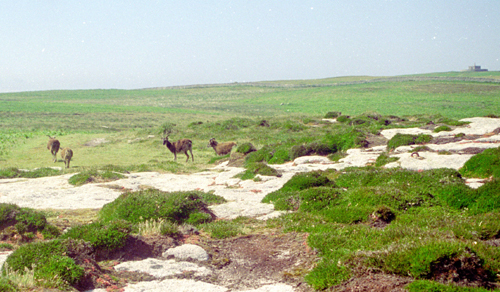The soay sheep has a good head for heights and is sure of foot. They are in their element clambering fearlessly on narrow cliff ledges. They may also appear on the menu at the Marisco Tavern. Warning to dyslexic vegetarians: these cuddly looking beasties must not be confused with the humble soya bean!

The Lundy pony is a tall and sturdily built quadruped. They were bred originally by crossing New Forest pony mares with an Arabian stallion. This one is seen browsing in front of St Helena's Church, built by the Rev Hudson Heaven in 1896. He was the second generation of the Heaven dynasty that owned the island from 1836 to 1918. Not surprisingly, Lundy became known as "the Kingdom of Heaven".

Only a distant glimpse here of a small gathering of the island's rather shy feral goats. They are skillful climbers like soay sheep, and are characteristically seen defying gravity on the cliffs. Tibbetts can be seen in the distance on the right. This is a former Admiralty lookout, now converted to holiday accommodation for the intrepid. It is the most isolated property on the island and has no mains electricity. A powerful torch is essential, as it is a long and tortuous journey in the dark to Tibbetts from the Marisco Tavern at closing time.

Sika are indigenous to South East Asia, and were introduced to Lundy in 1920. They usually lurk in the rhododendron bushes on the east of the island during the day, and are not often seen. On my most recent visit to the island in June 2018 almost all these thick bushes had been removed depriving the deer of their favourite hiding place. The tame youngster seen in the photo taken on my July 1994 visit was kept in an enclosure for some reason. Note the characteristic white spots on the summer coat.
Like many other deer, sika are successful breeders, and on a visit during March 2000 their numbers had grown considerably. They also seemed much less timid, being happy to browse in the open in sizeable herds in full view of human onlookers. Unsurprisingly, after the periodic sika cull those deer that are spared immediately revert to shy mode.
